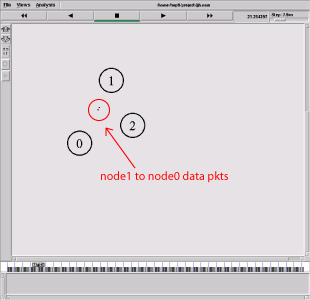| navigation |
| ..home.. |
| ..main goals.. |
| ..introduction.. |
| ..protocol descriptions.. |
| ..protocol differences.. |
| simulation results |
| ..conclusion.. |
| ..references.. |
simulation results | ||
Our simulation model plans to exploit the differences between the two routing protocols. We will show how the routing protocols respond to a changing topology while keeping all other factors constant. To simplify the example only three nodes are used, node0, node1, and node2. Throughout the simulation node1 is sending to node0 and initially is out of range of node0(see fig. 1). However, node2 is in range of both the other nodes so initially acts as a router for them. When node1 and node0 come into range of each other a difference in the routing protocols becomes apparent. Initially both protocols are sending packets through node2. When node1 comes in range of node0 packets sent using DSR will no longer use node2 (see fig. 2 & 3) while packets sent with AODV will (see fig. 4). | ||
 |
Figure 1. Initial scenario of node1 sending to node0 through node2 using AODV or DSR. | |
| Figure 2. Example of nodes using DSR. Node0 is sending a DSR packet to node1 after coming into range of each other. This packet will now allow node1 to send directly to node0. |  | |
| Figure 3. Node1 now sending to node0 using DSR. |  | |
 |
Figure 4. Example of nodes using AODV after node1 comes into range of node0. Notice that node1 will continue to send its packets through node2. | |
| | prev | next | | ||
| connections |
| ..Tom Paduano.. |
| ..Jonghoon Jeong.. |
| ..Network Simulator.. |
| ..Boston University.. |
| ..Slammed Magazine.. |